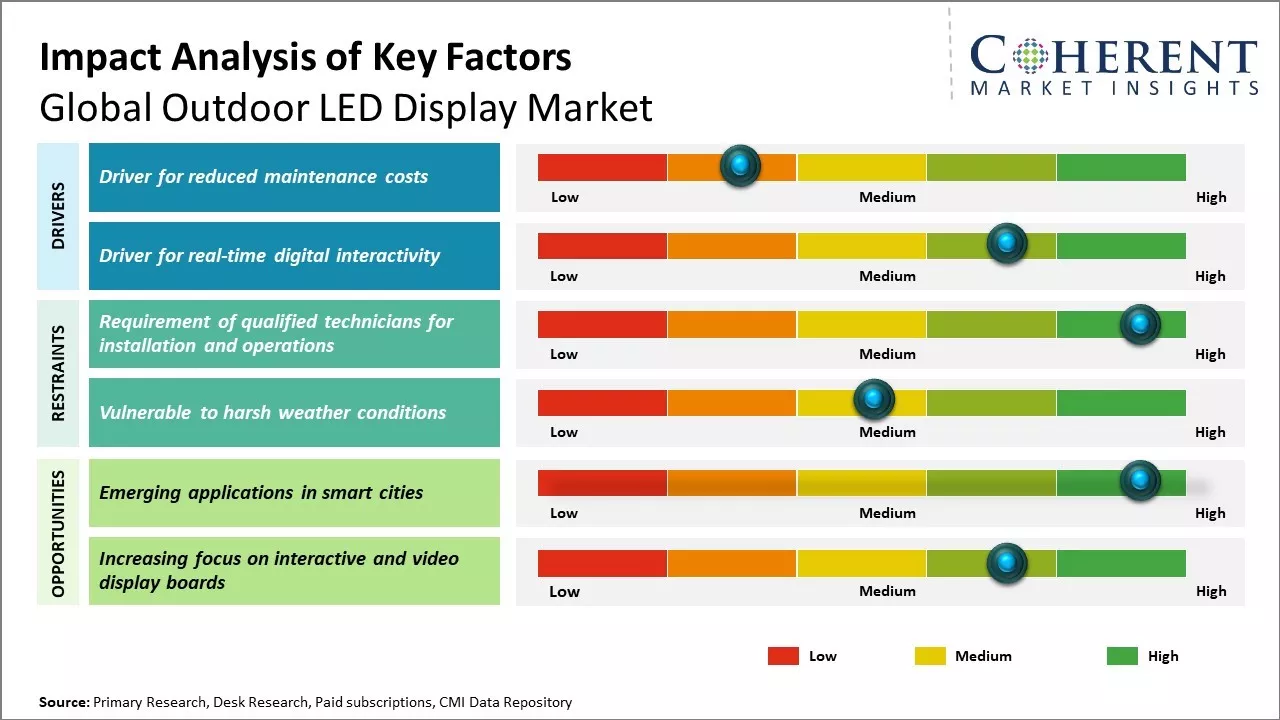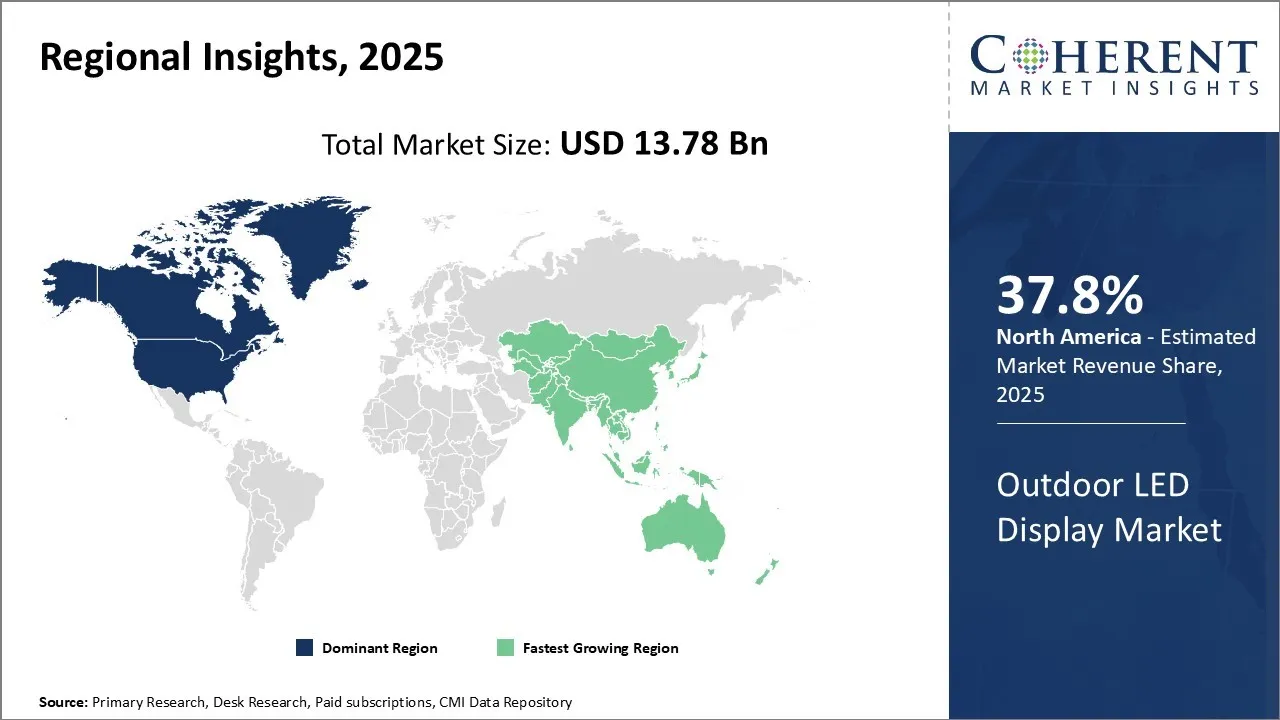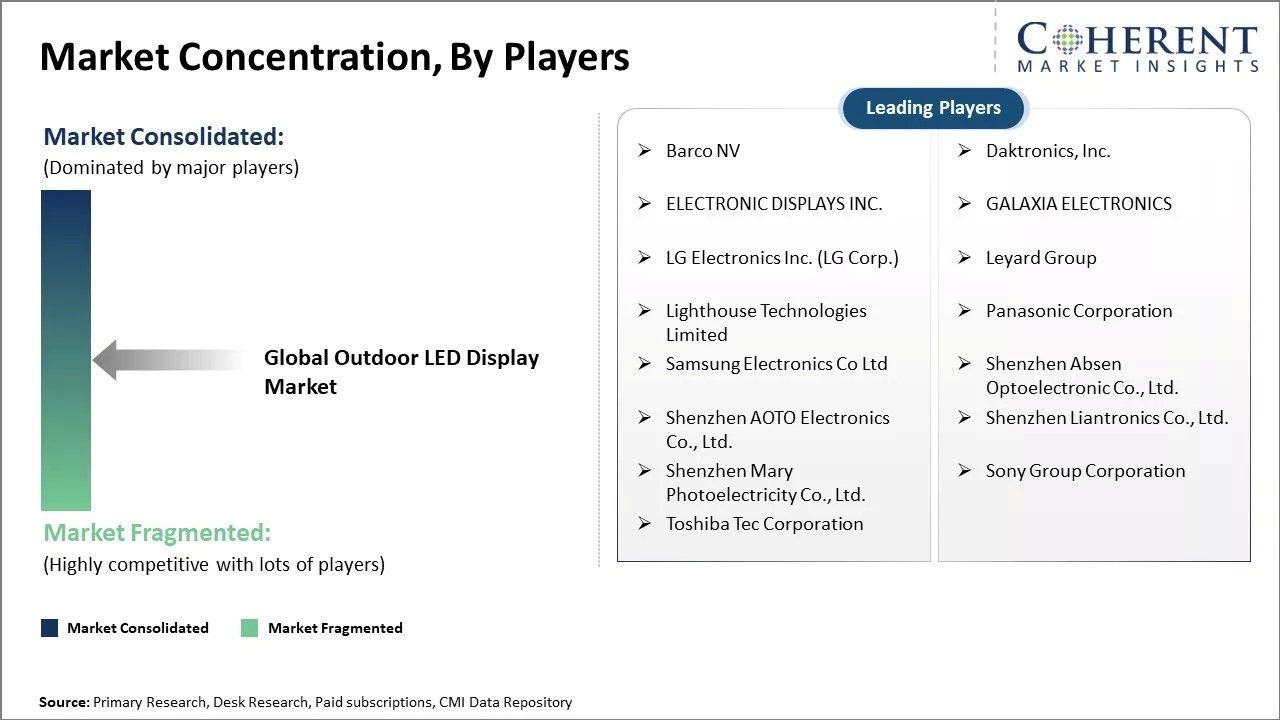The global outdoor LED display market is expected to be valued at USD 13.78 Bn in 2025. It is projected to grow at a compound annual growth rate (CAGR) of 11.3% during the forecast period, reaching USD 29.17 Bn by 2032.

To learn more about this report, Download Free Sample
The global outdoor LED display market is expected to grow rapidly during the forecast. This is mostly due to increasing adoption of digital signage for advertising and brand promotions at public places like airports, railway stations, etc.
Advancements in display technologies, such as higher brightness, better energy efficiency, and longer lifespan of LEDs, along with falling prices, are encouraging end users to replace traditional display solutions with LED displays. This will likely foster outdoor LED display market growth.
A Samsung representative, for instance, stated in 2021 that LED display prices had declined by roughly 50% in the preceding four to five years. This cost reduction is expected to boost sales of outdoor LED displays during the forthcoming period.
However, high initial investment costs involved in installing outdoor LED displays can hinder market growth during the forthcoming period. But the lower maintenance costs of LED displays over their lifespan can help overcome this challenge.
|
Current Event |
Description and its Impact |
|
Smart City Infrastructure Development Programs |
|
|
Technological Convergence and 5G Network Rollout |
|
Uncover macros and micros vetted on 75+ parameters: Get instant access to report
Surface-mounted LEDs are expected to dominate the global outdoor LED display industry, accounting for 58.9% of the revenue share in 2025. Their popularity stems from their ease of installation and maintenance.
Unlike individually mounted LED displays, surface mounted displays do not require extensive support structures or cabling works. They can be directly installed on any flat surface, such as walls or facades, thus simplifying the overall setup process. This makes surface mounted displays a more affordable and convenient solution for outdoor use.
Additionally, the secure mounting prevents issues like display falling or malfunctioning due to improper installation or wiring of individual displays. This results in significantly lower service costs and increased reliability throughout the lifespan of the project.
A recent development highlighting surface-mounted LEDs’ growing popularity is the Riyadh Municipality’s adoption of new Daktronics LED Displays. In June 2025, Daktronics completed the installation of 36 LED displays for Riyadh Municipality in Saudi Arabia. These displays use Surface-Mount Device (SMD) LED technology.
Based on application, LED billboards segment is expected to emerge as the top revenue generator with 40.2% share in 2025. LED billboards have gained immense popularity among advertisers seeking high visibility and mass reach of their marketing campaigns.
These advantages have propelled LED billboards to surpass other outdoor display segments in terms of advertising expenditure and installation growth rates. Their unmatched visibility and powerful advertising capabilities continue to solidify their dominant position in the outdoor LED display market.

To learn more about this report, Download Free Sample
North America has established itself as the dominant market for outdoor LED displays with a 37.8% share in 2025. This can be attributed to strong government support for the adoption of modern technologies across public infrastructure in the U.S. and Canada.
Major cities are investing heavily in upgrading their digital signage networks with LED billboards and video walls at airports, transit stations, and other public places. For instance, in September 2025, CHI Health Center Omaha selected Daktronics to design, manufacture, and install 37 LED displays throughout the venue ahead of the 2025 fall sports seasons.
Additionally, North American brands play a leading role in the outdoor LED display manufacturing industry. Their innovation allows the region to benefit from advanced product offerings and solutions tailored for the local climate and requirements.
Asia Pacific is emerging as the fastest-growing regional market globally. China, in particular, has seen a massive rollout of outdoor LED displays in tier 1 and tier 2 cities to promote brands and events.
Local manufacturers have gained expertise in producing high-quality, cost-effective displays. This has made outdoor LEDs an affordable medium for advertisers and municipal authorities alike.
Countries like India and Southeast Asian nations are also rapidly adopting digital signage networks as their urban infrastructure expands. The APAC region benefits from a large consumer base and the availability of skilled labor at competitive prices. This helps drive down production costs and gives regional players an edge in global export markets.
The thriving commercial real estate sector across major APAC cities has supported the installation of large-format video walls on high-rise buildings, shopping malls, and urban parks. Events culture is flourishing as well, with many destinations hosting international sports and cultural festivals regularly. This growing demand for experiential and impactful ways of audience engagement works in favor of the outdoor LED display market.
The U.S. outdoor LED display market is set to grow steadily during the forecast period, supported by high adoption of digital signage across cities. Airports, stadiums, shopping malls, and transit hubs are increasingly upgrading to LED billboards as well as video walls to enhance audience engagement.
Government initiatives for modernizing public infrastructure and strong demand from the advertising industry are key drivers. For example, several U.S. cities are installing energy-efficient outdoor LED billboards to reduce electricity consumption while ensuring high visibility.
Strong presence of leading players and rising demand for high-resolution, 3D, and interactive LED displays are also strengthening the market. In addition, growing investments from sports organizations, entertainment venues, and smart city projects will accelerate growth during the forthcoming period.
China is expected to remain one of the fastest-growing markets for outdoor LED displays. Rapid urbanization and large infrastructure projects are leading to widespread use of LED billboards in tier 1 and tier 2 cities.
Local manufacturers are making affordable and good-quality LED displays, which makes them easier to buy for private advertisers and city authorities. The rising use of digital screens for brand promotions, public messages, and entertainment events is also boosting demand.
For instance, Chinese cities are actively rolling out large outdoor LED walls for cultural festivals, sporting events, and government campaigns. This trend, along with rising exports of LED display technology from China to other nations, positions it as a global hub in the industry.

To learn more about this report, Download Free Sample
Top outdoor LED display companies are focusing on developing high-quality as well as energy-efficient display solutions. Innovations include ultra-bright screens, flexible LED panels, and smart displays with remote management capabilities.
Many LED display manufacturers are teaming up with advertising agencies, event planners, and local governments to provide complete digital signage solutions. To reach more customers worldwide, these companies are also growing through partnerships, mergers, and acquisitions. This helps them serve the rising demand from retail, transport, sports, and entertainment industries.
| Report Coverage | Details | ||
|---|---|---|---|
| Base Year: | 2024 | Market Size in 2025: | USD 13.78 Bn |
| Historical Data for: | 2020 To 2024 | Forecast Period: | 2025 To 2032 |
| Forecast Period 2025 to 2032 CAGR: | 11.3% | 2032 Value Projection: | USD 29.17 Bn |
| Geographies covered: |
|
||
| Segments covered: |
|
||
| Companies covered: |
Barco NV, Daktronics, Inc., ELECTRONIC DISPLAYS INC., GALAXIA ELECTRONICS, LG Electronics Inc. (LG Corp.), Leyard Group, Lighthouse Technologies Limited, Panasonic Corporation, Samsung Electronics Co Ltd, Shenzhen Absen Optoelectronic Co., Ltd., Shenzhen AOTO Electronics Co., Ltd., Shenzhen Liantronics Co., Ltd., Shenzhen Mary Photoelectricity Co., Ltd., Sony Group Corporation, and Toshiba Tec Corporation |
||
| Growth Drivers: |
|
||
| Restraints & Challenges: |
|
||
Uncover macros and micros vetted on 75+ parameters: Get instant access to report
The global outdoor LED display outlook appears promising. One of the key drivers for its growth is the reduced maintenance costs associated with LED displays compared to traditional display technologies such as LCD.
Outdoor LED displays are increasingly preferred by commercial clients such as stadium owners, shopping mall operators, and public transport authorities due to their long lifespans and durability in harsh outdoor conditions. Unlike LCD and plasma screens that have bulky components, outdoor LED displays utilize solid-state lighting, which produces bright visuals using little electricity and offers robustness.
The compact modular construction of LED display panels makes them relatively simple to install and replace individual LED units if they malfunction. This allows issues to be fixed quickly without needing to overhaul the entire display system. In contrast, the full replacement of outdated LCD or plasma screens entails higher labor and material costs.
Outdoor LED displays also do not require frequent and expensive bulb replacements like traditional billboards. Their energy-efficient design leads to significant savings on electricity bills over time.
More importantly, outdoor LEDs are far more resilient to damage from external factors such as rain, snow, humidity, and extreme temperatures. This translates to low maintenance and repair expenditure throughout the display's lifespan of over 100,000 hours of usage.
Another major driver for the rising popularity of outdoor LED displays is their ability to go beyond static advertisements and offer powerful real-time digital interactivity. This interactivity allows businesses to engage site visitors and passers-by through immersive multimedia experiences.
For example, outdoor LED displays deployed at sports stadiums can showcase live scores, polls, games, and crowd reactions during matches to ramp up viewer excitement. At public venues, they help disseminate important alerts and updates to crowds.
Shopping malls use interactive LED screens to show promotions, store maps, and directions. Transportation hubs use them to share real-time updates, schedules, and information about delays in flights or trains.
Modern outdoor LED displays also come with touchscreen features that let businesses gather useful customer data. By offering games, quizzes, or surveys on these screens, companies can learn about customer preferences, track behavior, and improve their marketing strategies.
Real-time data feedback allows instant analysis of responses which traditional static billboards cannot offer. Furthermore, interactive digital content holds viewer attention for longer durations compared to passive advertisements.
Rapid urbanization and focus on building smart cities present a massive opportunity for the outdoor LED display manufacturers globally. As more cities adopt smart technologies to improve living standards and provide better services to citizens, the need for advanced outdoor displays will see significant growth.
Smart city initiatives involve installing various sensors and devices and integrating them with centralized control systems to optimize infrastructure management, transportation systems, law enforcement, environmental monitoring, and more. These technologies enable real-time data collection and management, improving urban planning and public services.
An important aspect of smart cities is keeping citizens informed about civic announcements, emergency alerts, and real-time information. This is where outdoor LED displays come into play as they offer municipalities and local administrations an engaging platform to disseminate important messages and advisories to people seamlessly.
Sources
Share
Share
About Author
As an accomplished Senior Consultant with 7+ years of experience, Pooja Tayade has a proven track record in devising and implementing data and strategy consulting across various industries. She specializes in market research, competitive analysis, primary insights, and market estimation. She excels in strategic advisory, delivering data-driven insights to help clients navigate market complexities, optimize entry strategies, and achieve sustainable growth.
Missing comfort of reading report in your local language? Find your preferred language :
Transform your Strategy with Exclusive Trending Reports :
Frequently Asked Questions
Joining thousands of companies around the world committed to making the Excellent Business Solutions.
View All Our Clients